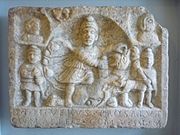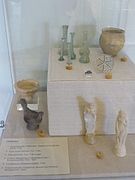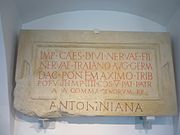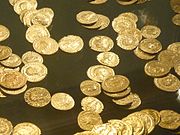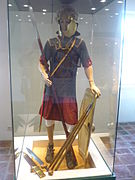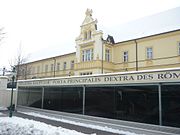Roman Museum Tulln
The Roman Museum Tulln in Tulln an der Donau ( Lower Austria ) is mainly dedicated to the history as well as the exhibition and presentation of finds from the fort and civil settlement ( vicus ) of Comagena .
history
The museum, founded in 1928, was refurbished in 2001 in the priory of the former Dominican convent . The u. a. Exhibition rooms, co-designed by Hanns Jörg Ubl (Austrian Federal Monuments Office ), show the military-historical significance of this ancient cavalry fort by means of equipment, military diplomas and inscriptions . The various activities of the garrison troops are vividly depicted in tin figure dioramas . A large number of finds from civil settlements and graves complement this comprehensive exhibition. It is possible to start with a 15-minute audio slide show about life in the Comagena Castle.
In front of the museum entrance at Marc-Aurel-Park 1b there is a statue of Jupiter Dolichenus , whose cult was probably brought from Asia Minor by the first occupying force of the fort, ala I Commagenorum .
structure
The exhibition area is divided into four rooms (three corridors and a vaulted hall).
- In the first and second corridor rooms, the Roman army organization, the structure of the Noricum province and two other forts ( Fort Augustianis , Fort Zwentendorf ) in Tullnerfeld are presented.
- In the large vaulted hall, the military life on the Noric Danube border and also the recruiting area (Kingdom of Commagene ) of the first verifiable occupation force, the Ala I Commagenorum , are shown, as well as their armament (figurines) and original finds of Roman weapons, coins and objects of daily use .
- Finds from the Roman burial grounds are presented in the third corridor. A replica of a double burial with original additions can be seen on the front wall. Including a tile grave as well as urn graves and a cremation burial.
Among the most important finds in the museum are the remains of an inscription in which the name of the fort is mentioned. A model shows the position of the camp under the area of today's city of Tulln. Numerous finds (glasses, jewelry, ceramics, inscriptions, remains of grave structures, a large hoard of coins) document the life of the civil population in ancient Comagena . The exhibition ends with finds from late antiquity , some of which are of poor quality. At that time the fort had already turned into a civilian oppidum and lost all military importance. At the end of Roman rule, St. Severin appeared in Noricum and made several stops in Comagena on his travels through the province.
Illustrations
Architectural monuments and excavations
The most impressive visible remnant of the camp is the salt tower, an almost completely preserved Valentinian U-tower from the late 4th century, it is located near the banks of the Danube, on the corner of Nibelungengasse and Wassergasse.
In the cellars of some houses on Wienerstraße, the remains of the southern fortification wall (defense wall and southwest corner tower) have been preserved.
The foundation walls of the south-eastern corner tower were preserved in the courtyard of the sports school in Bonvicinistraße and surrounded by a protective structure. The tower is only accessible with a guide. In the former garden of the hospital, on the east side of the museum building, the remains of the porta principales dextra (east gate), accessible from Zant-Allee, have been preserved. The walls have been restored and conserved and have been presented in a largely glazed protective structure since 2001. The panorama picture on the back wall gives a view of the interior of the camp at the time of the 2nd century AD.
The excavations under the Minorite Monastery can be viewed in the Tulln City Museum in the exhibition "Tulln underground - city archeology in Tulln".
About two kilometers outside of Tulln, on the road to Königstetten , there is a Roman milestone (still at its original location) . This monument, known as the Nietzinger milestone, once stood on the road that connected Vindobona (Vienna), Comagena and Aelium Cetium (St. Pölten). It was set at the time of Emperor Macrinus (217/218) and indicated the distance from Aelium Cetium (26 miles). However, his inscription is no longer legible today. A copy of this stone, including the complete inscription, is in the roundabout on Severinsplatz.
swell
- Herwig Friesinger, Fritz Krinzinger: The Roman Limes in Austria, guide to the archaeological monuments. Publishing house of the Austrian Academy of Sciences, Vienna 1997, p. 230.
Folder:
- Römisches Tulln, A guide through the Roman museum and the Roman buildings in the city area
- Roman Museum Tulln
Web links
- Tulln Roman Museum, website of the municipality of Tulln
- The Roman Limes in Austria, List of Limes Museums in Austria (sorted alphabetically by municipality)
Footnotes
Coordinates: 48 ° 19 '59.8 " N , 16 ° 3' 25.6" E

